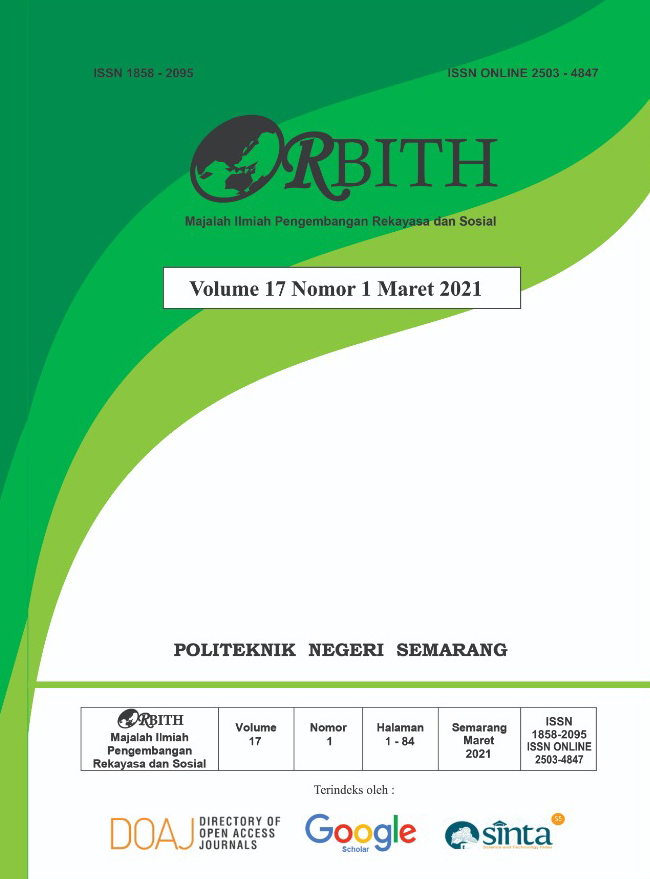ANALISA BIODIGESTER POLYETHILENE SKALA RUMAH TANGGA DENGAN MEMANFAATKAN LIMBAH ORGANIK SEBAGAI SUMBER PENGHASIL BIOGAS
DOI:
https://doi.org/10.32497/orbith.v17i1.2937Keywords:
biogas, biodigester polyethylene, limbah organikAbstract
Biodigester polyethylene merupakan salah satu alternatif reaktor biogas yang murah dan mudah dalam pembuatannya serta cocok untuk biodigester skala kecil. Tujuan dari penelitian ini adalah mendapatkan karakteristik dari biodigester polyethylene dan volume spesifik biogas yang dihasilkan. Penelitian ini dilakukan dengan menggunakan biodigester skala rumah tangga dengan limbah organik (jerami) dan air sebagai bahan baku penghasil biogas, dengan komposisi rasio perbandingan volume 1:1, 2:1, dan 1:2 untuk jerami dan air. Pengamatan temperatur operasi dan tekanan biogas yang dihasilkan dilakukan selama 20 hari untuk mendapatkan volume spesifik biogas. Hasil penelitian menunjukkan kerja biodigester polyetilene skala rumah tangga, dimana kapasitas digester terhitung sebesar 0,416 m3 pada komposisi rasio perbandingan volume jerami dan air 1 : 1 menunjukkan hasil yang lebih baik daripada komposisi rasio perbandingan sampel lainnya.
Kata kunci : biogas, biodigester polyethylene, limbah organik
References
Alawi, S., Zainuri, B., Meisam, T., Shahrakbah, Y., Suraini, A. A., Ali, H. M., and Yoshihito, S. 2009. The Effect of Higher Sludge Recycling Rate on Anaerobic Treatment of Palm Oil Mill Effluent in a Semi-Commercial Closed Digester for Renewable Energy. Biotechnology, 5,1-6.
Apriandi, N. MS., Kusuma, I. G. B. W., dan Widiyarta, I. M. 2013. Pemurnian Biogas Terhadap Gas Pengotor Karbondioksida (CO2) dengan Teknik Absorbsi Kolom Manometer. Jurnal Logic, Vol. 13, No. 1.
Atabani, A.E., Silitonga, A. S., Badruddin, I. A., Mahlia, T. M. I., Masjuki, H. H.m and Mekhilef, S. 2012. A Comprehensive Review on Biodiesel as an Alternative Energy Resource and its Characteristics. Renewable and Sustainable Energy Reviews, 16(4): 2070-2093.
Ehrlich, P. R., and Holdren, J. P. 1971. Impact of Population Growth. Science, 171(3977): 1212-1217.
Ganzoury, M. A., and Allam, N. K. 2015. Impact of Nanotechnology on Biogas Production : a Mini Review. Renew. Sustain. Energy Rev. 50 : 1392-1404.
Indartono, Y. S. 2005. Reaktor Biogas Skala Kecil Menengah. http://www.beritaiptek.com.
Kapdi, S. S., Vijay, V. K., Rajest, S. K., and Prasat, R. 2004. Biogas Scrubbing, Compression, and Storage : Perspective and Prospectus in India Context. Renewable Energy, 4: 1-8.
Martins das Neves, L. C., Converti, A., and Vessoni Penna, T. C. 2009. Biogas Production : New Trends for Alternative Energy Sources in Rural and Urban Zones. Chemical Engineering & Technology, 32(8): 1147-1153.
Raff, R. A. V., and Allison, J. B. 1956. High Polymer : Polyethilene.. Interscience Publisher Inc, New York. Vol.X.
Rajaeifar, M. A., Hemayati, S. S., Tabatabaei, M., Aghbashlo, M., And Mahmoudi, S. B. 2019. A Review on Beet Sugar Industry with a Focus on Implementation of Waste-to-Energy Strategy for Power Supply. Renew. Sustain. Energy Rev. 103: 423-442.
Septiani, M., Nuhardin, I., and Muliawan, A. 2020. Biogas Fermentation from Vegetable Waste and Horse Rumen Involving Effective Microorganism-4 (EM4). INTEK Jurnal Penelitian. Vol.7(1): 08-12.
Sihombing, B. S. J. 2006. Pembuatan Biogas Dari Limbah Ternak Sapi dengan Penambahan Sekam Padi. Tugas Akhir. Denpasar, Bali.
Simamora, S. 1998. Pengolahan Limbah Peternakan (Animal Waste Management) : Teknologi Energi Biogas. Fakultas Politeknik Pertanian IPB, Bekerjasama denan Direktorat Pendidikan Menengah Kejuruan, Dirjen Pendidikan Dasar dan Menengah, Departemen P dan K.
Valijanian, E., Tabatabaei, M., Aghbashlo, M., Sulaiman, A., and Chisti, Y. 2018. Biogas Production System, In Tabatabaei, M., Ghanavati, H. (Eds). Biogas, Biofuell, and Biorefinery Technologies. Springer, Cham. Pp.95-116.
Van Vlack, L. H. 1994. Ilmu dan Teknologi Bahan (Ilmu Logam dan Bukan Logam). Alih Bahasa oleh Sriati Djaprie. Erlangga, Jakarta.
Downloads
Published
Issue
Section
License
Authors who publish with this journal agree to the following terms:Authors retain copyright and grant the journal right of first publication with the work simultaneously licensed under a Creative Commons Attribution License that allows others to share the work with an acknowledgement of the work's authorship and initial publication in this journal.
Authors are able to enter into separate, additional contractual arrangements for the non-exclusive distribution of the journal's published version of the work (e.g., post it to an institutional repository or publish it in a book), with an acknowledgement of its initial publication in this journal.
Authors are permitted and encouraged to post their work online (e.g., in institutional repositories or on their website) prior to and during the submission process, as it can lead to productive exchanges, as well as earlier and greater citation of published work (See The Effect of Open Access).






